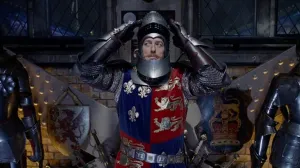
Even casual observers of superhero comics expected the first issues of House of X and Powers of X (henceforth referred to as HoXPoX) to be enormous hits. Marvel Comics had placed an enormous amount of resources into this intertwined relaunch of the X-Men franchise, including the return of fan favorite writer Jonathan Hickman, months of teasers and advertisements, and promises that this moment would change the X-Men forever (unlike the past half dozen relaunches). If Marvel Comics wants to make a #1 issue land big, they know exactly how to make it happen. However, after five issues HoXPoX is still the center of critical attention each week it lands. Comics Twitter is abuzz with theories and discussion of new revelation, reviews are generally glowing about every aspect of the series, and comic book stores are reporting a very positive sales reception.
Videos by ComicBook.com
While HoXPoX is technically two series, they are published and listed in a very specific reading order. The final page of each individual issue even lists the order under the banner: “TWO SERIES THAT ARE ONE.” That makes HoXPoX a 12-issue miniseries, a format that is familiar to any fan of American superhero comics. It’s the format that the biggest events of the 1980s embraced, as both Secret Wars and Crisis on Infinite Earths stuffed entire universes into (literally) earth-shattering stories. More prestigious miniseries aiming to provide a literary bent to comics, like Watchmen and Squadron Supreme, embraced the same format. Even after almost 40 years, modern prestige miniseries continue to use that 12-issue number as shorthand for importance—just consider Tom King’s style in The Vision and Mister Miracle.
Framing a superhero story in 12 issues is no guarantee of success or even respect, however. Plenty of comics that embrace this style and plenty more that operate with fewer issues fail to draw acclaim or sustained attention. So what is it about miniseries like HoXPoX that make them a hit issue after issue?

HoX & PoX So Far
A brief review of the issues released in HoXPoX so far suggests a central element to its success because every issue provides a concept or style that is unique within the series. House of X #1 delivered a new status quo for the X-Men and mainstream Marvel universe. The seeds of Krakoa and establishment of a new mutant nation delivered enough fresh concepts for an entire 12-issue miniseries. That didn’t stop Powers of X #1 from delivering an entirely different narrative framework, time-hopping across four different eras separated by powers of 10 (i.e. Year 1, Year 10, Year 100, and Year 1000).
That pair of hooks, again, could easily have sustained two distinct 6-issue series, but that has not been the case. House of X #2 rebuilt the character of Moira MacTaggert, transforming her into Moira X, telling a new story of reincarnation with almost a dozen distinct timelines. Subsequent issues of Powers of X have continued to build on the existing story and expand the styles in which it is told, including an embrace of the superhero event climax in Powers of X #3 with a battle that rages across all of its pages.
What has made HoXPoX a constant delight to discuss is that any conversation cannot center solely on plot. Every new issue is exploring the comics form as much as it is advancing individual character arcs or moving timelines forward. It is a miniseries that never repeats itself in style or substance, and that is essential to its success.

Reflecting on the Classics
While some of the concepts utilized in the pages of HoXPoX are certainly innovative, nothing about its overall approach is. Comics creators have been differentiating longform stories by differentiating their approach to individual issues for decades. Right now Ed Brubaker and Sean Phillips are doing the same in the pages of Criminal as the series’ longest story to date unfolds from a different perspective and approach to the noir genre in each issue.
The most obvious example of this would date back to the pages of Watchmen in 1986. Like HoXPoX it tells a sprawling superhero story packed with characters, history, and ample material beyond the standard grids of drawn, caped figures. The two are very different on a thematic level, but they each seek to do something different within each issue. Watchmen #5 is renowned for its symmetrical construction, with layouts and color schemes that reflect one another from the outside moving inward towards the series’ false climax. Every issue of that legendary story can be distinguished by at least one unique storytelling element. The same can be said of similarly beloved comics from the same time. While The Dark Knight Returns relates a narrative with a clear plot progression and distinct chapters, those chapters slowly alter the style of artwork utilized by Frank Miller and his collaborators. The density and clean lines of the first issue become much more wild by the final one. Reflecting on the superhero genre’s classics, it becomes apparent that experimentation is more of an issue-by-issue feature than a project-by-project one.

The Exceptional Nature of Comics
Observing how today’s most critically-acclaimed comics and the classics of the past vary their narratives with each issue is not a revelation, but it is a reminder as to what makes comics a distinctly rewarding medium. Television, radio, and other formats provide similar forms of serialization, providing room to adapt between episodes, but none offer the variety found in comics. That variety is special, but not exactly rare. HoXPoX provides an example, but similar observations could be structured around The Omega Men, Criminal, and plenty more recent series.
HoXPoX is a particularly suitable example because of how much it leans into the adaptability of the comics medium. Every single issue delivers at least one new storytelling element that can be analyzed, discussed, and dissected. Each element makes the overall story more rewarding. In HoXPoX they are used to construct a history that is unlike anything found in Marvel movies, television series, or prose. It moves with ease between multiple timelines, characters, and sci-fi concepts without ever losing track of the big picture. That flexibility in experimenting with individual issues, one that still enhances the overall narrative, is rewarding and something that can be done more effectively in comics than any other medium. It’s just one more reason why HoXPoX is a series to be celebrated.








